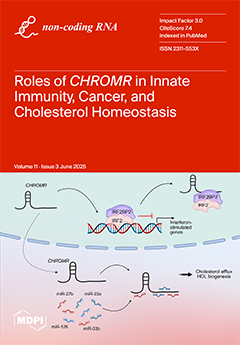Background/Objectives: X-inactive-specific transcript (
XIST) is a factor that plays a role in neuroinflammation. This study investigated the role of
XIST in neuronal development, neuroinflammation, myelination, and therapeutic responses within cerebral organoids in the context of Multiple Sclerosis (MS) pathogenesis.
Methods
[...] Read more.
Background/Objectives: X-inactive-specific transcript (
XIST) is a factor that plays a role in neuroinflammation. This study investigated the role of
XIST in neuronal development, neuroinflammation, myelination, and therapeutic responses within cerebral organoids in the context of Multiple Sclerosis (MS) pathogenesis.
Methods: Human cerebral organoids with oligodendrocytes were produced from
XIST-silenced H9 cells, and the mature organoids were subsequently treated with either FTY720 or DMF. Gene expression related to inflammation and myelination was subsequently analyzed via qRT-PCR. Immunofluorescence staining was used to assess the expression of proteins related to inflammation, myelination, and neuronal differentiation. Alpha-synuclein protein levels were also checked via ELISA. Finally, transcriptome analysis was conducted on the organoid samples.
Results:
XIST-silenced organoids presented a 2-fold increase in the expression of neuronal stem cells, excitatory neurons, microglia, and mature oligodendrocyte markers. In addition,
XIST silencing increased IL-10 mRNA expression by 2-fold and MBP and PLP1 expression by 2.3- and 0.6-fold, respectively. Although
XIST silencing tripled IBA1 protein expression, it did not affect organoid MBP expression. FTY720, but not DMF, distinguished MBP and IBA1 expression in
XIST-silenced organoids. Furthermore,
XIST silencing reduced the concentration of alpha-synuclein from 300 to 100 pg/mL, confirming its anti-inflammatory role. Transcriptomic and gene enrichment analyses revealed that the differentially expressed genes are involved in neural development and immune processes, suggesting the role of
XIST in neuroinflammation. The silencing of XIST modified the expression of genes associated with inflammation, myelination, and neuronal growth in cerebral organoids, indicating a potential involvement in the pathogenesis of MS.
Conclusions:
XIST may contribute to the MS pathogenesis as well as neuroinflammatory diseases such as and Alzheimer’s and Parkinson’s diseases and may be a promising therapeutic target.
Full article






